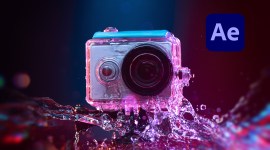The Dolly Shot: How It Works and Why It’s Powerful
There’s nothing more cinematic than a great dolly shot, but they’re not always easy to pull off. Learn how dolly shots work technically and for storytelling, and how you can achieve them on your own.
The dolly shot is a common filmmaking technique that you’ve likely heard of before — it’s nearly as common as a panning or zooming shot. Dolly shots have produced some of the most legendary scenes in movie history, like the dolly zoom into Chief Brody’s face in Jaws, to more recent marvels, like cinematographer Hoyte van Hoytema’s legion of tracking shots in Dunkirk, Spectre, and more.
The dolly shot is an essential tool for filmmakers and cinematographers. In this guide, we’ll explore several dolly shot variations and different camera setups that are frequently used. We’ll also share some creative methods you can use to create your own dolly shot, for both professionals and filmmakers on a budget.
What Is a Dolly Shot?
The term dolly refers to a wheeled cart, usually one that runs on rail tracks. A dolly shot refers to the camera movement when a camera is mounted on a dolly. In a dolly shot, the camera moves towards, away from, or alongside your subject, which can be an actor, location setting, product, etc. Because the camera dolly is mounted on rail tracks the movement is smooth and controlled – almost as if the camera is floating.
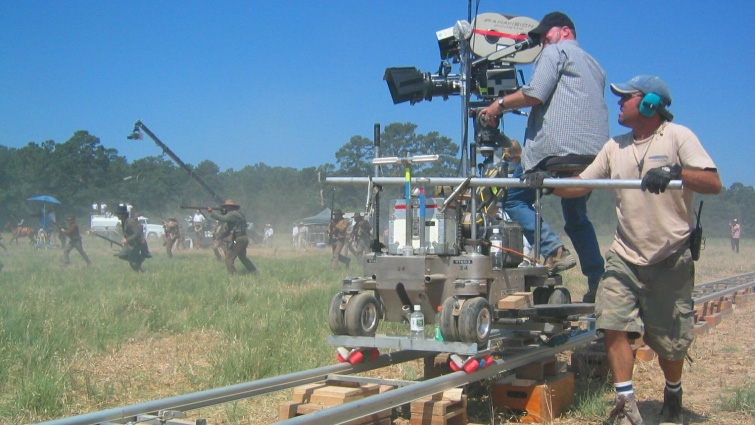
Dolly Shot vs. Tracking Shot
Anything shot with a camera dolly can also be considered a tracking shot, because the camera is usually following or moving toward the subject. Tracking shots with camera dollies usually require the camera to film perpendicular to the rail tracks, otherwise the rail tracks will be visible in the scene. However, visible track rails can be removed in post-production, as you can see in the Mindhunter VFX Breakdown. If you have rails visible in your own shots, try using Content-Aware Fill in After Effects to remove them.
Different Types of Dolly Shots
As the camera dolly moves, you can simultaneously adjust camera settings to create various dolly shot types, such as adjusting the camera tilt, rotation, or focal zoom. Here are some of the most important types of dolly shots.
1. Dolly In and Dolly Out
A standard dolly shot usually refers to smoothly moving the camera forward or away from your subject, labeled “dolly in” and “dolly out,” respectively. Any secondary camera movement is minimal, such as a slight tilt up or down. Manually adjusting the focus distance may be required during the movement, in order to keep your subject in focus. This slow inward dolly shot in Citizen Kane is a classic example.
2. Dolly Zoom
The dolly zoom (also known as a zolly) is probably the most popular variant of the dolly shot. By adjusting the camera zoom during the dolly movement, the foreground subject will stay the same size, while the background will appear to open or narrow. Check out this dolly zoom shot in The Lord of the Rings.
Accomplish the dolly zoom by dollying toward your subject while simultaneously zooming out. Conversely, you can dolly backwards, away from your subject, while zooming in. Here is a more in-depth article from PremiumBeat about the cinematic power of the dolly zoom.
If you don’t have a zoom lens, you can still create the dolly zoom effect in post-production, since zooming in with a lens has a similar effect to scaling up footage in post. Read this breakdown on how to create a dolly zoom with a prime lens.
3. Dolly with Secondary Camera Movement
You can also add secondary camera movement during your camera dolly. This secondary movement could be panning, tilting, or rolling the camera. This is a common technique if your subject is moving, or you need to draw attention to something specific. In this video tutorial, Brent Pierce shows how you can add a dutch angle to a dolly shot.
4. Tracking Shot
Tracking dolly shots usually scroll alongside your actors through a scene. They can be a great way to show actors moving from one location to another. Tracking shots can be done on dolly rails, or you can find an alternative to a dolly, like a Steadicam or 3-axis Gimbal. Check out this video to learn the basics of tracking shots.
5. Long Tracking Shot
A long tracking shot is basically a normal tracking shot on steroids. They’re also frequently referred to as “one takes.” Long tracking shots often involve moving through a scene, usually following an actor, without any visible cuts for a lengthy period of time. The difficulty comes from having to get everything right in “one take.” Most one takes are done with Steadicams, since the map of the shot can be quite winding and complicated. However, it is possible to capture one with a camera dolly – as long as you have enough rail length!
The opening scene of Spectre features a long tracking shot.
6. 360 Dolly Shot
A 360 dolly shot essentially orbits around your subject. This creates a dramatic parallax between the subject and the background. In order to achieve a 360 dolly shot with a camera dolly, the crew will need to use a circular rail track, then position their subject in the center of it. A 360 shot is much easier with something like a Steadicam or motorized 3-axis Gimbal, especially if you’re on a budget. Check out this 360 shot from the TV show LOST.
7. Spike Lee Dolly Shot
The Spike Lee dolly shot is an alternative take on the traditional tracking shot. In this shot, not only is the camera on a dolly, but the actor is as well. This creates a floating-like appearance as the actor moves through the scene. Check out this montage of the Spike Lee dolly shot.
The Purpose of a Dolly Shot
So, what is the purpose of a dolly shot? Of course, film is subjective so there can be multiple meanings for a wide variety of different dolly shots. However, if we just focus on the standard dolly in or dolly out, we can explore some of the more common motivations.
Draw In the Viewer’s Attention
The movement of dollying inward is a great way to gear the viewer’s attention to something specific. It’s almost as if they ‘re leaning in to get a closer look. The slow dolly movement creates a more dramatic effect, making it hard to ignore what’s on screen.
Reveal a Location
Dollying forward or backwards can be a great way to reveal the details of a location. This is very common with location establishing shots. A forward dolly might move toward a closed door, implying that something’s happening behind it. Or a backwards dolly might reveal unexpected features of a location that were previously hidden from the viewer. Here’s a montage of establishing shots from Harry Potter, many of which have dolly movements.
Create Depth
Since dolly shots move through a scene, they create visual parallax that helps sell the depth of the location. This is particularly important when you want to show the audience the scale of something — big or small — on screen.
Character Realization
Frequently, dolly shots are used to focus in on a character when they’re thinking, or when they come to a realization about something important. This acts as an unspoken cue to the audience that something is happening. This technique can quickly create tension and stir all kinds of emotions, from anticipation to dread. Take the famous dolly zoom scene from Jaws, when Chief Brody’s worst fears have been realized.
Industry Dolly Equipment
There’s a lot of professional dolly equipment on the market. Deciding on the right rig comes down to the scale of your project and how much you want to spend. Here’s a list of film industry tools frequently used for dolly shots.
Cinema Platform Dolly
These are the cream of the crop when it comes to dolly equipment. Cinema platform dollies are likely the ones you’ve seen in behind-the-scenes for most blockbuster movies. Chapman/Leonard is one of the premiere dolly manufacturers; check out this video featuring one of their latest, the Hybrid IV Camera Dolly. To get your hands on one of these, you’ll likely need to contact a professional equipment rental house.
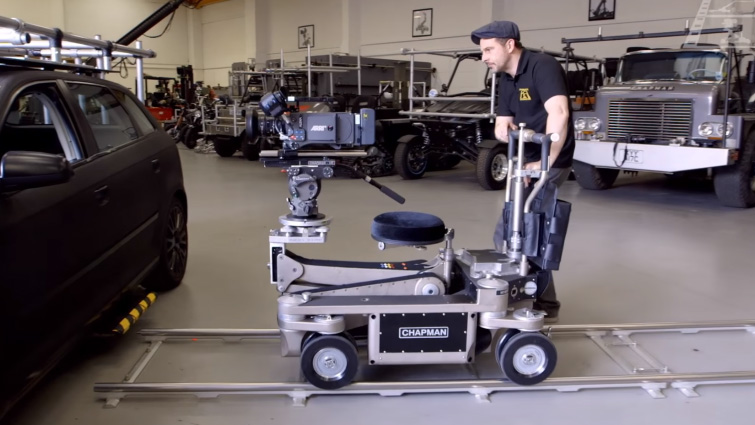
Image via Chapman-Leonard.
Doorway Dolly
A doorway dolly is essentially a flat, stable platform with wheels. It’s narrow enough to fit through average doorways, hence the name. Think of this as a bare bones variant of a cinema platform dolly. Price points can vary depending on features, but overall, these are much more affordable for most small studios. The Matthews Doorway Dolly is a popular option.
Slider
Think of a slider as a miniature cinema platform dolly, without the dolly. This setup mounts your camera directly on the rail tracks. It’s ideal for smaller dolly movements, when there’s no reason for the operator to also be on the rails. I’m a big fan of sliders, and there are numerous options on the market now. Kessler Crane makes some of the best in terms of quality.
Tripod Dolly
A tripod dolly is another affordable option. These are wheels that connect to the legs of your existing tripod, allowing you to roll and move the camera around freely. This tripod dolly set from Magnus is a good example. However, it’s worth noting that these are designed to work best on a smooth studio floor, such as glossy concrete or commercial carpet. Because of the solid wheel design, tripod dollies won’t work well on anything outside with an uneven surface.
Steadicam
While a Steadicam is not the same as a dolly, it does offer the same type of tracking camera movement. It’s a camera stabilizer that mechanically isolates the operator’s movement through a mechanism of counterweights, springs, and balancing. Because of this, the operator needs to be quite skilled to utilize it correctly. Steadicams have been used for decades in the film industry and are still being used today. Check out this video showcasing countless Steadicam examples.
3-Axis Gimbal
A gimbal is another tool that’s not a dolly, but one that can be used for tracking shots. A motorized 3-axis Gimbal works similarly to a Steadicam, but the electronic motors do all of the balancing work. This makes it a viable option for operators who haven’t ever used a Steadicam before. DJI makes some of the most popular 3-axis Gimbals, like the Ronin-SC. It’s worth noting, though, that 3-axis Gimbals can frequently create a look that’s almost too static. Because of that, I wouldn’t consider a 3-axis Gimbal a true substitute for a Steadicam – but both have their benefits.
Other Specialty Film Equipment
There are many more industry dolly options out there. For instance, cable camera systems, like those from DEFY Products, offer plenty of unique rigs. Similarly, you can opt to use a professional drone, such as the DJI Inspire 2. This gives you the ability to create smooth dolly shots in many directions, without track rails and other equipment. Drones can be especially useful for remote location shoots and establishing shots. Finally, a more affordable option is a table top dolly. These are wheeled setups that usually mount on a smaller camera body, allowing you to smoothly move it across a table top.
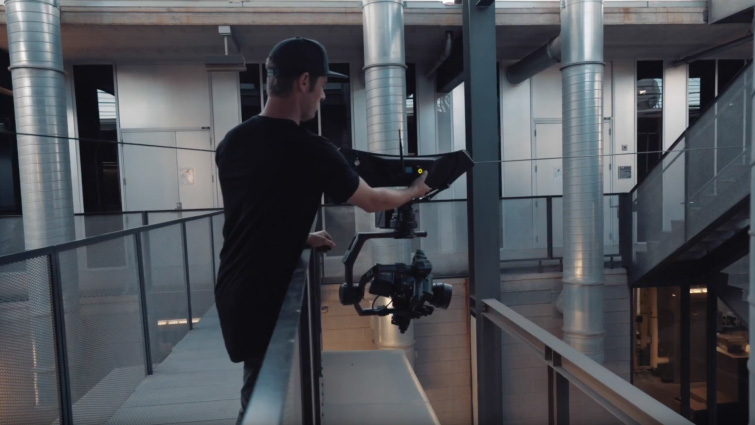
Image via DEFY Products.
Non-Traditional Dolly Equipment
If industry dolly equipment is outside of your budget, or if you’re just looking to get creative, there are plenty of non-traditional methods for creating a dolly shot. Here’s a list of some of our favorites.
Wheelchair
Using a wheelchair as your dolly is incredibly effective. Think about it — you have a stable place for the camera operator to sit, you have smooth and stable wheels that also allow for turning, and you have handles in the back that allow a second operator to steer. Check out this great list of DIY filmmaking techniques using a wheelchair dolly.
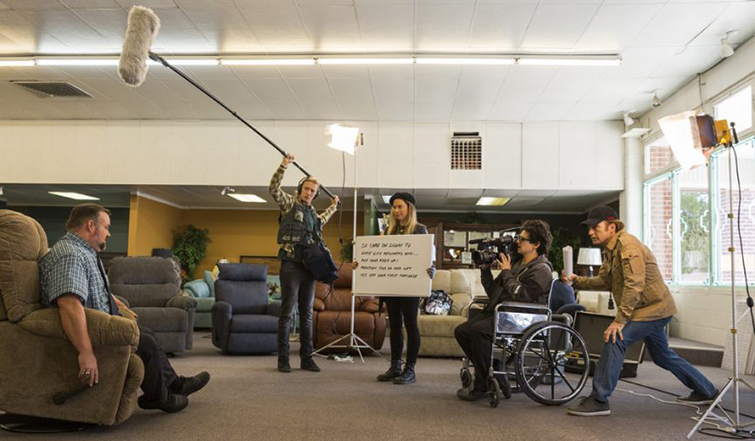
Image via AMC.
Vehicle
A vehicle has wheels, so why not utilize that as a dolly? Not only that, it has shocks and air tires that help create smooth movements. Check out this tutorial for using your vehicle as a dolly system. My personal favorite is sitting down and filming from the back of the tailgate. If your vehicle footage ends up looking a little too bumpy, you may want to utilize some post-stabilization software.
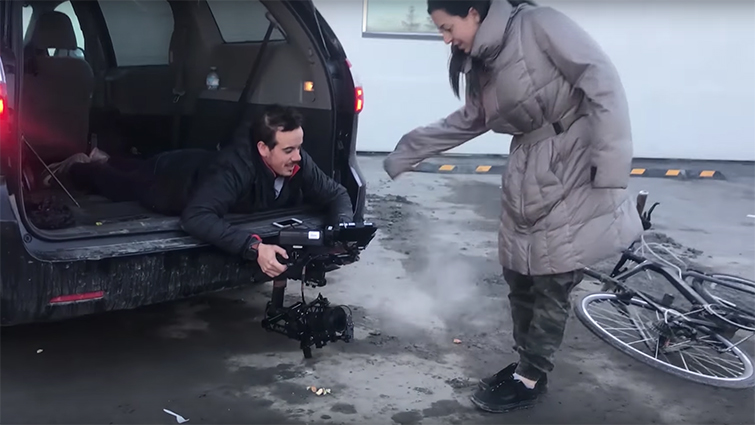
Roller Skates
Roller skates and roller blades are a super cheap option. Obviously you’ll probably want to practice wearing them first – I don’t recommend putting on a pair for the first time and immediately grabbing your expensive camera! Footage from operators filming on roller skates can be remarkably smooth, and they’re even occasionally utilized on blockbuster movies. In this video, see how the team at Shutterstock Tutorials used rollerblades to pull off a long take:
Onewheel
Onewheels have surged in popularity with filmmakers in recent years. They can be operated hands-free and have an aired tire that helps smooth out the movement. They can even be utilized on trails off-road, which is remarkable. I’ve seen them used in behind-the-scenes quite a bit in recent years, usually with the operator holding a motorized 3-axis Gimbal.
Small Drone
Smaller drones like the DJI Mavic Air are great portable dolly options. And because of their small size, you don’t have to worry about them creating as much wind that will disturb your footage. You can even use them indoors with various slow-moving modes, such as “tripod mode” on DJI drones.
Making Your Own DIY Dolly on a Budget
Sometimes building something custom is the best way to tailor your equipment, save money, and learn something new. Here’s a list of do-it-yourself dolly solutions.
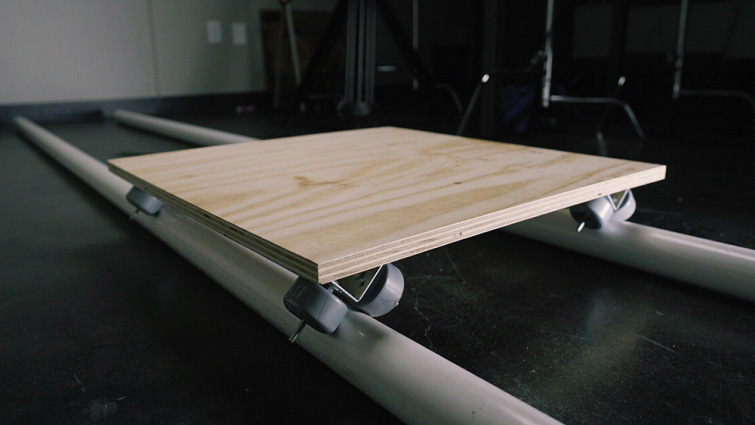
PVC Pipe Dolly
A PVC pipe dolly is probably the most popular DIY method for filmmakers. For around $60 and a trip to a hardware store, you can get everything you need to build one for yourself. Check out this step-by-step tutorial for how to build your own PVC dolly. And, for an alternative take, check out this PVC dolly tutorial made by David F. Sandberg, director of Shazam! and Lights Out.
Butt/Pedestal Dolly
For this DIY dolly, you’ll need: a bar stool seat, a boat seat pedestal, and a plant caddy. All of these items will cost you around $140. By attaching them, you’ll create a neat rolling seat, perfect for coordinating your own dolly movements. Note, you’ll only want to utilize this method on smooth surfaces. Mark Vargo breaks down the entire process of the DIY butt/pedestal dolly in this article.
Tennis Ball Dolly
You may have seen cut tennis balls placed on the back legs of walkers. This is because the tennis balls cut down on friction and help slide the walker on smooth surfaces. The same concept can work with a tripod, if you have a glossy studio floor or smooth hardwood floor. Purchase a pack of three tennis balls and carefully make a two inch cut (or puncture) in each one. Place those over the feet of your tripod. Now you should be able to slide the tripod around. Always keep both hands locked on the tripod, though, otherwise you risk tipping it over. Check out this video tutorial for the tennis ball dolly.
More DIY Dolly Builds
If you need even more DIY dolly options, check out this article with 10 Cheap Tripod Dolly Hacks. All of these DIY builds utilize a tripod in conjunction with other objects, such as paper cups, PVC pipe, and production carts.
Discover more cinematography tips and DIY builds:
- 6 Affordable Ways to Capture Great Dolly Shots
- 4 Ways Still Photography Can Make You a Better Cinematographer
- The Lost Joys of Using DIY Filmmaking Equipment
- Everything You Need to Know About Chroma Key and Green Screen Footage
- Choosing Aspect Ratio: A Guide to Everything You Need to Know
Cover image from Transformers via Paramount Pictures

